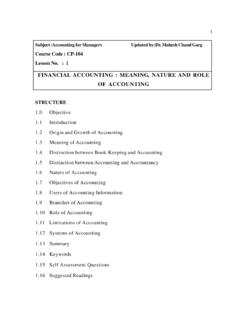Transcription of GOOD VIDEO GAMES AND GOOD LEARNING …
1 good VIDEO GAMES AND good LEARNING . James Paul Gee Tashia Morgridge Professor of Reading University of Wisconsin-Madison Madison, WI 53706. I played my first VIDEO game four years ago when my six-year-old son Sam was playing Pajama Sam: No Need to Hide When It's Dark Outside. In Pajama Sam, child super-hero Sam mine and the virtual one goes off to the Land of Darkness to find and capture Darkness in a lunch pail and thereby alleviate fear of the dark. Darkness turns out to be a big lonely softie who just needs a playmate. I wanted to play the game so I could support Sam's problem solving. Though Pajama Sam is not an educational game , it is replete with the types of problems psychologists study when they study thinking and LEARNING . When I saw how well the game held Sam's attention, I wondered what sort of beast a more mature VIDEO game might be.
2 I went to a store and arbitrarily picked a game, The New Adventures of the Time Machine perhaps, it was not so arbitrary, as I was undoubtedly reassured by the association with H. G. Wells and literature. As I confronted the game I was amazed. It was hard, long, and complex. I failed many times and had to engage in a virtual research project via the Internet to learn some of things I needed to know. All my Baby-Boomer ways of LEARNING and thinking didn't work. I felt myself using LEARNING muscles that hadn't had this much of a workout since my graduate school days in theoretical linguistics. As I struggled, I thought: Lots of young people pay lots of money to engage in an activity that is hard, long, and complex. As an educator, I realized that this was just the problem our schools face: How do you get someone to learn something long, hard, and complex and yet enjoy it.
3 I became intrigued by the implications good VIDEO GAMES might have for LEARNING in and out of schools. And, too, I played many more great GAMES like Half-Life, Deus Ex, Halo, Elder Scrolls III: Morrowind, Rise of Nations, and Legend of Zelda: The Wind Waker. good VIDEO GAMES incorporate good LEARNING principles, principles supported by current research in Cognitive Science (Gee 2003, 2004). Why? If no one could learn these GAMES , no one would buy them and players will not accept easy, dumbed down, or short GAMES . At a deeper level, however, challenge and LEARNING are a large part of what makes good VIDEO GAMES motivating and entertaining. Humans actually enjoy LEARNING , though sometimes in school you wouldn't know that. Before I talk about LEARNING in GAMES , I must deal with the content question. People are prone to say, in a dismissive way, What you learn when you learn to play a VIDEO game is just how to play the game.
4 Ironically, we actually find here our first good LEARNING principle. Some people think of LEARNING in school for example, LEARNING biology as all about LEARNING facts that can be repeated on a written test. Decades of research, however, have shown, that students taught under such a regime, though they may be able to pass tests, cannot actually apply their knowledge to solve problems or understand the conceptual lay of the land in the area they are LEARNING ( , Gardner 1985). A science like biology is not a set of facts. In reality, it is a game certain types of people play . These people engage in characteristic sorts of activities, use characteristic sorts of tools and language, and hold certain values; that is, they play by a certain set of rules . The do biology. Of course, they learn, use, and retain lots and lots of facts even produce them but the facts come from and with the doing.
5 Left out of the context of biology as activity, biological facts are trivia. So, ironically, just as what you learn when you learn to play a good VIDEO game is how to play the game, so too, what you learn when you learn biology should be how to play that game. However, for both VIDEO GAMES and biology, it's not a case of anything goes this is not a permissive progressivism writ large. You have to inhabit the identity the game offers (be it Battle Mage or field biologist) and you have to play by the rules. You have to discover what the rules are and how they can best be leveraged to accomplish goals. Perhaps the word game rankles some use simulation instead. However, keep in mind that a game like Full Spectrum Warrior is a game when I buy it off the rack, but serious LEARNING when a soldier plays the professional training version.
6 So, let's take a brief look at some of the LEARNING principles good GAMES incorporate (Gee 2003, 2004, 2005). 1. Identity. No deep LEARNING takes place unless learners make an extended commitment of self for the long haul. LEARNING a new domain, whether it be physics or furniture making, requires the learner to take on a new identity: to make a commitment to see and value work and the world in the ways in which good physicists or good furniture makers do. good VIDEO GAMES capture players through identity. Players either inherit a strongly formed and appealing character , Solid Snake in Metal Gear Solid or they get to build a character from the ground up, as in Elder Scrolls III: Morrowind. Either way, players become committed to the new virtual world in which they will live, learn, and act through their commitment to their new identity.
7 Why should the identity of being and doing science be less appealing? 2. Interaction. Plato in the Phaedrus famously complained that books were passive in the sense that you cannot get them to talk back to you in a real dialogue the way a person can in a face-to-face encounter. GAMES do talk back. In fact, nothing happens until a player acts and makes decisions. Then the game reacts back, giving the player feedback and new problems. In a good game, words and deeds are all placed in the context of an interactive relationship between the player and the world. So, too, in school, texts and textbooks need to be put in contexts of interaction where the world and other people talk back. 3. Production. Players are producers, not just consumers; they are writers not just readers . Even at the simplest level, players co-design GAMES by the actions they take and the decisions they make.
8 An open-ended game like Elder Scrolls III: Morrowind is, by the end, a different game for each player. In a massive-multi-player game like World of WarCraft thousands of people create different virtual careers through their own unique choices in a world they share with many others. At a higher level, many GAMES come with versions of the software with which they are made and players can modify them. Such modifications range from building new skate parks in Tony Hawk or new scenarios in Age of Mythology to building whole new GAMES . Players help write the worlds they live in in school, they should help write the domain and the curriculum they study. 4. Risk Taking. good VIDEO GAMES lower the consequences of failure; players can start from the last saved game when they fail. Players are thereby encouraged to take risks, explore, and try new things.
9 In fact, in a game, failure is a good thing. Facing a boss, the player uses initial failures as ways to find the boss's pattern and to gain feedback about the progress being made. School too often allows much less space for risk, exploration, and failure. 5. Customization. Players can usually, in one way or another, customize a game to fit with their LEARNING and playing styles. GAMES often have different difficulty levels and many good GAMES allow players to solve problems in different ways. In a role-playing game, the distinctive attributes each player chooses for his or her character determines how the game will be played. Players can even try out new styles, thanks to the risk taking principle above. Customized curricula in school would not just be about self pacing, but about real intersections between the curriculum and the learner's interests, desires, and styles.
10 6. Agency. Thanks to all the preceding principles, players feel a real sense of agency and control. They have a real sense of ownership over what they are doing. Such ownership is rarer in school. 7. Well-Order Problems. Research has shown that when learners are left free to roam in a complex problem space as they sometimes are in permissive hands on . environments they tend to hit on creative solutions to complex problems, but solutions that don't lead to good hypotheses about how to solve later, even easier problems (Elman 1991). In good VIDEO GAMES , the problems players face are ordered so that the earlier ones are well built to lead players to form hypotheses that work well for later, harder problems. It matters how the problem space is organized that's why GAMES have levels . Equal thought needs to be paid to how to order problems in a rich immersive space in a science classroom, for example.






